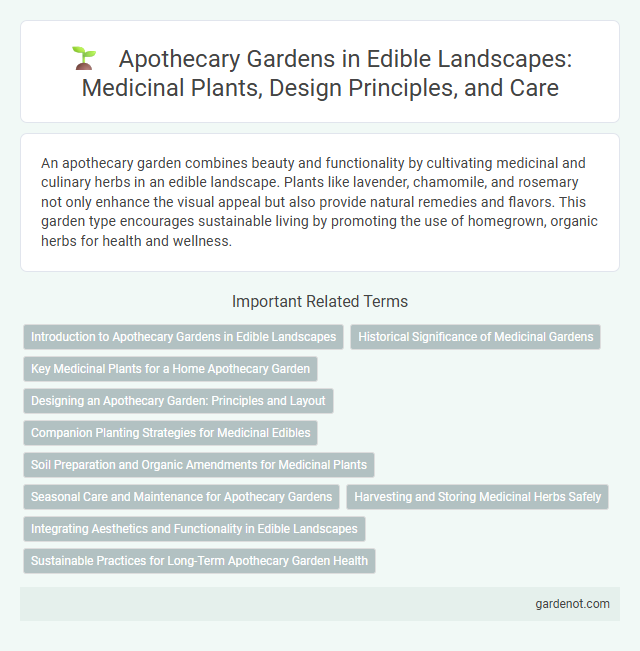An apothecary garden combines beauty and functionality by cultivating medicinal and culinary herbs in an edible landscape. Plants like lavender, chamomile, and rosemary not only enhance the visual appeal but also provide natural remedies and flavors. This garden type encourages sustainable living by promoting the use of homegrown, organic herbs for health and wellness.
Introduction to Apothecary Gardens in Edible Landscapes
Apothecary gardens are designed to cultivate a variety of medicinal and culinary herbs, integrating plants like lavender, chamomile, and thyme into edible landscapes. These gardens emphasize the dual purpose of beauty and functionality by providing natural remedies and enhancing biodiversity. Incorporating apothecary gardens promotes sustainable gardening practices while preserving traditional herbal knowledge.
Historical Significance of Medicinal Gardens
Apothecary gardens, historically integral to medicinal knowledge, served as living pharmacies cultivating herbs like chamomile, lavender, and peppermint for healing purposes. These gardens originated in monastic communities during the Middle Ages, where monks meticulously studied and preserved medicinal plants, contributing significantly to the development of early pharmacology. Their design and plant selection reflect centuries of traditional herbal medicine, influencing modern edible landscapes focused on health and wellness.
Key Medicinal Plants for a Home Apothecary Garden
Key medicinal plants for a home apothecary garden include Echinacea, known for its immune-boosting properties, and Calendula, which aids in skin healing and inflammation reduction. Lavender offers calming effects and can be used in teas or topical applications, while Chamomile is prized for its digestive and sleep-enhancing benefits. Mint varieties provide relief from digestive issues and headaches, making these plants essential for a functional and healing edible landscape.
Designing an Apothecary Garden: Principles and Layout
Designing an apothecary garden requires integrating medicinal herbs like lavender, chamomile, and echinacea into a functional and aesthetically pleasing layout. Emphasizing principles such as companion planting, accessibility, and soil health ensures the garden supports plant vitality and easy harvest. Structured beds, labeled plantings, and pathways facilitate organization while promoting sustainable cultivation of healing plants.
Companion Planting Strategies for Medicinal Edibles
Apothecary gardens utilize companion planting strategies to enhance the growth and potency of medicinal edibles by pairing herbs based on their synergistic properties and pest-repellent abilities. Plants such as basil and chamomile improve the essential oil content and yield of nearby medicinal herbs like lavender and echinacea, while marigolds deter harmful insects, promoting a healthier edible landscape. These companion plants create a balanced ecosystem that supports soil health, boosts plant resilience, and maximizes the therapeutic value of the garden's medicinal produce.
Soil Preparation and Organic Amendments for Medicinal Plants
Rich, well-draining soil with a slightly acidic to neutral pH (6.0-7.0) is ideal for apothecary gardens to support medicinal plant health and potency. Incorporating organic amendments such as compost, aged manure, and biochar enhances soil structure, nutrient availability, and microbial activity, fostering robust plant growth. Regularly testing soil and applying natural fertilizers like kelp meal or fish emulsion ensures optimal nutrient balance tailored to the specific needs of medicinal herbs.
Seasonal Care and Maintenance for Apothecary Gardens
Apothecary gardens require seasonal care involving pruning medicinal herbs to promote healthy growth and prevent disease. Soil enrichment with organic compost in spring ensures nutrient availability for potent phytochemical production. Regular monitoring for pests and adjusting water schedules based on seasonal rainfall optimize plant vitality and therapeutic efficacy.
Harvesting and Storing Medicinal Herbs Safely
Harvesting medicinal herbs in an apothecary garden requires timing each plant's peak potency to preserve active compounds. Use clean, sharp tools to prevent damage and contamination while harvesting leaves, flowers, or roots, and avoid collecting herbs near pollution sources. Store dried herbs in airtight, dark containers with labeled dates to maintain efficacy and prevent mold or degradation over time.
Integrating Aesthetics and Functionality in Edible Landscapes
Apothecary gardens blend medicinal plants like lavender, chamomile, and echinacea with ornamental landscaping to create visually appealing and functional edible landscapes. Strategic plant placement enhances both aesthetic charm and accessibility for harvesting, promoting wellness through natural remedies. Incorporating diverse textures, colors, and scents fosters a therapeutic environment that supports biodiversity and sustainable gardening practices.
Sustainable Practices for Long-Term Apothecary Garden Health
Implementing sustainable practices in apothecary gardens ensures long-term health by promoting soil fertility through organic composting and crop rotation. Incorporating native medicinal plants adapted to local climates reduces water consumption and pest issues, enhancing ecological balance. Utilizing companion planting and natural pest control methods minimizes chemical use, fostering a resilient and thriving apothecary ecosystem.
Apothecary garden Infographic

 gardenot.com
gardenot.com